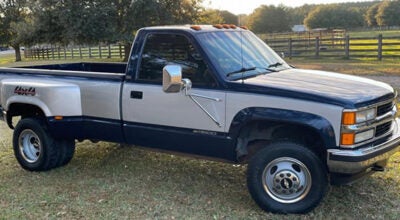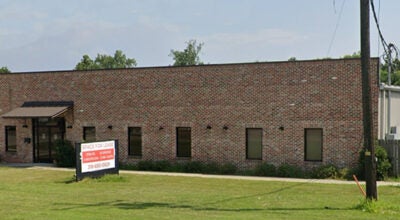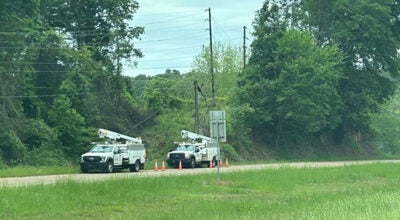Is Mississippi River reaching higher levels, more often?
Published 12:06 am Sunday, June 5, 2011
By Taylor Aswell & Hannah Mask
NATCHEZ — The waters of the Great Flood of 2011 are receding, and it appears the Miss-Lou is again safe from Mississippi River flooding, but for how long?
The river at Natchez has reached three of its top 12 highest levels ever in the last four years and has crested at or above flood stage 29 times since 1970. The river only crested at or above flood stage 17 times from 1903 to 1969.

NASA satellite images show the difference between the Mississippi River in 2010, at right, when it was not flooding, and the river on May 15, 2011, at left, when it was approaching the highest crest ever recorded in Natchez.
The 2011 crest at Natchez — 61.9 — is the highest ever.
The river is reaching higher levels more often, and it’s a reality local residents can’t ignore, Vidalia Mayor Hyram Copeland acknowledged.
“I think this is an issue we are going to have to address,” he said. “We are going to have to get the (U.S.) Corps of (Engineers) and Congress to look at this and see if there is anything that can be done.”
But the problem is one no one should be surprised about, experts said, and there is no easy solution.
The levees
The very things that protected Vidalia and thousands of other river residents up and down the Mississippi last month — levees — are part of the problem, according to Karen O’Neill, associate professor in the human ecology department at Rutgers University and author of a book focused on flood control, “Rivers by Design.”
“The question is always ‘Where can the water go?’” O’Neill said.
If levees force rising waters into a smaller area, she said, the water rises only within that area.
“At some point, it’s just a question of volume,” O’Neill said. “Levees closer to the river give the river less room to spread at flood time.”
Historically, she said, people built their houses on relatively higher land and planted crops in the low areas, taking the risk that those areas would be flooded at times whether they were protected by the levee or not.
Now, though, as the design of levees becomes more advanced, O’Neill said, there’s a temptation to build them closer to the river to protect farmlands.
“Private individuals and county and state government cut off some of the historic natural outlets, (as well),” she said. “The floodways that have been built since then do not replace the functions of these outlets.”
Franklin Heitmuller, an assistant professor in the Department of Geography and Geology at the University of Southern Mississippi said, too, that levees are part of the problem.
“The bad comes with the good,” he said.
“Flood-control levees are absolutely critical in this day and time to protect lives, communities and properties,” he said. “If (the levees) were absent — or poorly built — we would have a big mess on our hands.”
However, Heitmuller said, unintended problems arise.
“At locations where flood-control levees reduce the area (for floodwater), the floodplain can build up more rapidly than would otherwise be expected if floodwaters and sediment were distributed across a larger area,” he said.
Continued development
O’Neill said another problem created in recent years is the amount of infrastructure that’s been built.
“We’ve effectively converted rainfall into a social problem,” she said.
The addition of concrete covers — parking lots, shopping centers, houses and more — on previously porous open ground means rainfall can’t drain where it used to.
“We didn’t like muddy streets in the 19th century, so we eventually built storm drainage systems,” O’Neill said.
The problem with the drainage systems, O’Neill said, is they rush rainwater to rivers and seas instead of allowing it to become groundwater, as it would have in the past.
But it’s not just infrastructure that brings up issues with drainage.
“Most lawns are actually impervious to rainwater, because the ground is too compacted,” O’Neill said. “So suburbanization, as well as dense urban building, yields storm water problems.”
Varying weather systems can cause periodic flooding, she said, despite infrastructure. On the other hand, disastrous flooding happens because humans are in the way, but it’s difficult for engineers to estimate just how in the way humans are, she said.
“Somewhat simplistically, the river levees have provided exceptionally good protection against small- and medium-sized floods since the federal government first got involved,” O’Neill said. “But in keeping ever-increasing water volume inside the levees, we run the risk of catastrophic failure.”
Heitmuller, though, said he’s not convinced urban infrastructure — along with the associated pavement and reduction of seepage — is much of a factor for floods on a river the size of the Mississippi.
“In the case of the Mississippi River, the periodic nature of flooding is an expected, natural phenomenon,” he said. “Although humans can’t directly control meteorological conditions responsible for flooding our rivers, infrastructure — dams, reservoirs, flood-control levees and spillways — can modify the effects.”
Both agree, though, that no “quick fix” exists.
“This is a problem of human behaviors and expectations,” O’Neill said. “People who live in regularly flooded areas actually develop what scientists call ‘disaster cultures,’ where they understand something about the risks, at least of ‘normal’ floods, and work around those expectations.”
In Vidalia, city officials are talking about just that.
“For one, I think we are going to have to swap our drainage on the riverfront to a pumping station instead of just draining the water into the river,” Copeland said. “When the water gets to a certain height we can’t use them.”
Copeland also said the city is thinking about adding additional flood protection in the form of a sea wall on the riverfront.
“If the water does start to get this high on a more regular basis, we are going to need some more structures that will help keep out the water,” he said.
The problem, O’Neill said, is humans can’t really set expectations for super storms.
“We have no idea where such events might happen,” O’Neill said. “If a levee were to fail along the hundreds of miles of levee lines, where would it fail? And how could we stop it once failure begins?
“This scenario is truly frightening, because the force of the river behind such a break would be tremendous.”
Flood control in action
Heitmuller said the U.S. Army Corps of Engineers has done all it can at this point in the 2011 flood, which includes opening up the Morganza Spillway, south of Natchez to move more water out of the river channel quickly.
“The intentional breach of the Birds Point Levee in Missouri and the opening of Morganza Spillway constitute the ‘quickest’ fix, but exemplify the hard choices made to ‘save most’ while ‘losing a few,’” he said.
There’s no alternative but to adjust expectations, O’Neill said.
“We have to be willing to sacrifice farmland and do so deliberately and with expectations understood,” she said. “And we have to create incentives or requirements in our zoning and other policies to increase infiltration upstream.
In Natchez, where the majority of the city sits protected on top of a large bluff, City Engineer David Gardner sees the concern, but thinks the country’s flood control system is working.
“The Corps has designed the navigational control of the river through the levee system to have the river be self-cleansing,” he said. “The theory is that through the levees the water gets out quicker, and because of this silt in the water doesn’t just sit there and build up. It gets pushed out, leaving you more volume inside the levee system to hold water.”
Gardner said the levees were also built to take curves out of the river so that the water can move out faster.
Gardner said he does not believe that the levees will be the cause for higher water levels for the area, but even if they did the benefits of having the levee system far outweigh the benefits of not having one.
“You definitely want them,” he said. “They do a good job of using the design inside the levees to make sure the water flows quick enough to get out.”





